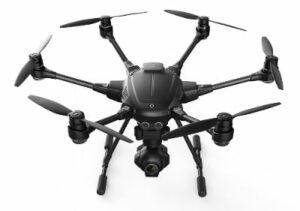 Yuneec International, a manufacturer of electric multirotor unmanned aerial vehicles, has announced the latest addition to its Typhoon series, the Typhoon H. Driven by customer demand for a more sophisticated drone, the Typhoon H is equipped with six rotors, a 360-degree gimbal camera and retractable landing gear.
Yuneec International, a manufacturer of electric multirotor unmanned aerial vehicles, has announced the latest addition to its Typhoon series, the Typhoon H. Driven by customer demand for a more sophisticated drone, the Typhoon H is equipped with six rotors, a 360-degree gimbal camera and retractable landing gear.
The 360-degree gimbal with the new CGO3+ camera allows unlimited panning for 4K videos and 12 megapixel stills. In addition, the landing gear retracts during flight to remove itself from the shot for unobstructed views. The Typhoon H adds new flight and image capture modes including Point of Interest, Orbit, Curved Cable and Journey. New safety features include ultrasonic proximity detection to assist in avoiding large obstacles, and a failsafe system which allows Typhoon H to remain stable and land if a motor should fail.
“A central part of our mission is to bring new and advanced creative possibilities within the reach of everyone,” said Yu Tian, chief executive officer of Yuneec International. “We’ve engineered the Typhoon H to redefine what customers should expect to pay for a drone with such an array of professional features.”
An additional benefit is the compact and user friendly design of the Typhoon H. Quick disconnect props allow speedy removal from the motors, and each rotor arm quickly folds down from its flight position for easy and compact transportation using a custom-designed hardcase/backpack. Carbon fiber is used extensively to decrease weight while increasing durability.
The Typhoon H comes with the Android-based ST16 controller, which has a large 7-inch integrated display and HD 720p video downlink for real-time video reception. Planned add-ons to the Typhoon H include a high performance collision avoidance module based on Intel RealSense Technology and an advanced IR camera module.
The Typhoon H also includes many safety features such as Geo-fencing, Variable Speed Control, Dynamic Return Home, Low-Battery Return Home and FAA No Fly.


















